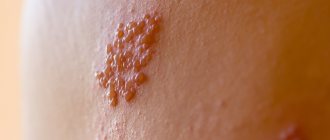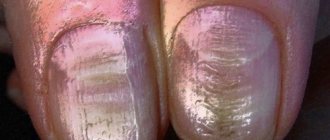Home » Departments » Phlebology - appointment with a phlebologist » Causes and treatment of spider veins on the chest in women
Spider veins (telangiectasias) are small skin formations that look like small dots, lines, and branches, usually red-violet in color. Such formations appear due to local expansion of the walls of the microvasculature structures with the formation of a protrusion. Spider veins on the chest of women not only bring psychological discomfort, but can also be a manifestation of the development of various pathological processes.
Signs of breast cancer
Signs of breast cancer in most cases are detected within the breast itself (in the early stages), with the exception of aggressive manifestations of cancer that have spread to distant organs, lymph nodes and tissues (late stages). If the tumor has penetrated beyond the breast, the clinical picture will look different. Migration of cancer cells is possible through the human lymphatic and circulatory system . It should be noted that many of the symptoms below are not unique to breast cancer. However, in any case, if you have one or more of these signs, you should immediately contact an oncologist for an in-depth diagnosis. When diagnosed with breast cancer, symptoms and treatment will be determined by the time the patient seeks medical help.
Breast structure
The content of the article
The structure of the breast consists of glandular and fatty tissue, as well as nerve and lymphatic tissue. The chest or mammary gland (Latin Mamma, Greek Mastos) lies on the pectoralis major muscle and extends from the 2nd to 6th ribs.
The female breast is a complex gland consisting of 15-20 individual glands. Each of them, together with connective and adipose tissue, forms one lobe. The lobes are separated from each other by connective tissue, and each of them has a drainage channel (duct), which connect and end in a funnel-shaped expansion on the nipple. Around the nipple is a darker pigmented band called the areola.
Symptoms of breast cancer
You should do a regular home breast exam between your doctor's visits every month, paying special attention to the symptoms listed below.
The most common symptom of breast cancer is the appearance of a new lump or lump. A painless, firm lump with an irregular outline is more likely to be cancerous, but malignant breast tumors can also be tender, soft, or round. Some women complain of obvious pain. Accordingly, if you have a new lump, lump or other change in the condition of the mammary glands, you need to be examined by an experienced specialist.
Other potential symptoms of breast cancer include:
- swelling of the whole mammary gland or part of it (even in the absence of lumps);
- the appearance of dimples on the skin (the skin looks like an orange peel);
- pain in the breast or nipple;
- nipple retraction;
- redness , dryness, flaking, or thickening of the skin of the breast or nipple;
- nipple discharge (other than breast milk);
- enlarged lymph nodes (sometimes breast cancer spreads to the lymph nodes in the armpit or around the collarbone and forms a lump there before the primary tumor in the breast grows large enough to be felt).
Although any of these symptoms may indicate a disease other than breast cancer, unusual symptoms should prompt you to see a doctor. Only a specialist can identify the real cause of your symptoms.
Remember that breast self-examination for signs of cancer does not replace regular mammograms and other screening procedures. Screening can detect breast cancer before symptoms appear. Early detection of cancer increases the chances of successful treatment.
3.Diagnostics and treatment
Diagnosis of a benign breast tumor
A thorough breast examination by a doctor will help make an accurate diagnosis and rule out breast cancer. If the patient has nipple discharge
, they can be analyzed to help determine the presence or absence of cancer cells.
Imaging examination of the mammary glands - mammography
or ultrasound of the mammary glands - will help determine whether the tumor is a homogeneous solid mass or filled with liquid.
Sometimes a biopsy
– taking a sample of cells or tissue from the breast and further examining it under a microscope.
Treatment of benign breast tumors
The choice of treatment for a benign breast tumor depends on what type of tumor has been diagnosed.
Thus, fibrocystic changes
do not require treatment.
A simple cyst
can be treated with a fine needle, and manipulation is often performed during diagnostic procedures. A breast biopsy uses a small needle. Removing fluid from the cyst using a needle will make the cyst disappear.
Fibroadenomas and intraductal papillomas
can be removed
surgically
.
About our clinic Chistye Prudy metro station Medintercom page!
Heredity factor as a sign of cancer
One of the mandatory actions in relation to a patient with breast cancer is to build his family tree and determine the need for genetic testing for the presence of BRCA genes . BRCA1 and BRCA2 are autosomal dominant genes that can be a sign of the development of breast cancer in up to 80% of relatives. There are several reasons to suspect the presence of these genes in the family:
- cases of cancer at a young age ;
- bilateral breast cancer , when after one breast is affected, the tumor forms in the second after some time;
- cases of breast cancer in men.
All of the above factors are a reason to conduct genetic testing to build a family tree for three generations and determine the mathematical probability of carrying the BRCA genes. Siblings and children of a carrier woman have a 50% chance of inheriting the gene . Thus, genetic testing is an effective method for preventing breast cancer.
Causes and risk factors
Every year in Russia alone, malignant tumors in this organ are detected in 50 thousand women. And worldwide this number exceeds a million. And the survival statistics are also disappointing so far. Almost half of the cases in women are fatal. Risk factors that can trigger tumor development include:
- hormonal imbalance;
- childlessness and having many children;
- very late first birth;
- frequent abortions;
- early onset and late cessation of menstruation;
- presence of mastopathy;
- age over 40 years;
- addiction to smoking and alcohol;
- obesity, as well as frequent stress;
- hypertonic disease;
- inflammation of the uterus and ovaries;
- atherosclerosis;
- hypothyroidism;
- liver diseases.
But it happens that cancer is discovered in patients who are not included in any of these risk groups.
Local cancer: symptoms
The clinical situation in this case can develop in four different directions:
1. The tumor is located in the middle part of the chest , in its glandular part. It is usually first discovered when a woman takes a bath or shower and notices a lump in one of her breasts. Immediate contact with a breast oncologist in such cases allows you to diagnose cancer even before the first clinically significant symptoms appear.
2.
The tumor is located near the nipple .
This localization of the tumor has two characteristic symptoms: deformation and retraction of the nipple (this is especially noticeable in comparison with the other nipple) and bloody discharge from the nipple. 3. The tumor has formed under the skin . In such cases, it manifests itself as a non-healing and unpleasant-smelling (due to bacterial infection) ulceration on the skin or “orange peel”, the appearance of which is caused by the accumulation of fluid due to compression of the lymphatic vessels.
4. The tumor lies deep in the thickness of the glandular tissue near the pectoral muscle, partially growing into it. A sign of this location of the tumor is a distinct asymmetrical shape in a bent position at the waist.
Check the price with a specialist
Breast cancer by lymphatic system
Spreading through the lymphatic vessels, the tumor can penetrate the axillary lymph nodes. In this case, the following symptoms are observed:
- enlargement of lymph nodes up to clearly palpable nodules
- accumulation of cancer cells in the armpit area
Less commonly, the tumor may migrate through the internal thoracic duct, which runs under the breastbone. Symptoms: since the tumor affects deep-lying lymph nodes, it can only be detected using instrumental diagnostic methods .
An even rarer case is a lesion of the supraclavicular lymph node, which manifests itself as a palpable lump in the area between the lower part of the neck and the upper rib. As it grows further, it can put pressure on the brachial plexus, causing loss of sensation in the fingers or shooting pain in the shoulder.
Late symptoms
At stages 3-4, symptoms and signs of breast cancer are associated with a significant increase in the size of the tumor, its growth into the chest wall and other nearby tissues. Distant metastases may be detected. They most often affect the bones, spine, spinal cord, lungs, and liver.
What breast cancer looks like depends on its clinical form. Often the disease is detected only at stage 3 or later. At this time, the tumor can be distinguished with the naked eye. It is already growing into the chest wall, which is accompanied by pain. Skin ulcers often appear with breast cancer. Symptoms of intoxication may occur.
With a large tumor size, progressive weight loss is often observed, since the tumor, for its growth, consumes a large amount of nutrients, which it “takes” from the blood.
In the later stages of breast cancer, open wounds on the skin of the breast may bleed and fester. They don't heal. The tumor may be partially located outside the mammary gland rather than inside it. Pus and necrotic masses are released from the nipple. Bleeding occurs from time to time.
In stage 4 breast cancer, symptoms are also associated with the presence of sites of metastasis. Clinical signs depend on the location of metastases. If they are present in the bones, pain and pathological fractures are possible.
In the case of metastatic damage to the structures of the respiratory system due to breast cancer, fluid in the lungs causes shortness of breath and often becomes the direct cause of death. Possible damage to the spinal cord with the development of sensory and motor disorders, dysfunction of the pelvic organs.
Symptoms of breast cancer in the circulatory system
If the tumor spreads through the blood vessels, then most often metastases are found in the following organs and tissues:
- bones. Symptoms: large metastases can disrupt the integrity of the periosteum, causing severe pain. Bone mineral density decreases, leading to fractures. A special case is a fracture of the vertebrae, which results in the so-called. compression (radicular)
- lungs. Symptoms: when they enter the lungs, tumor cells usually form several separate groups that form multiple metastases. Their development causes depression of pulmonary function, manifested by shortness of breath (dyspnea). When the bronchi are damaged, a painful dry cough develops (if nearby blood vessels rupture - cough
- brain. Symptoms: as metastases grow, they begin to put pressure on neurons, which causes their irritation (resulting in seizures) or partial shutdown (resulting in loss of mobility, loss of vision, sensitivity, etc.). Since the skull is a limited space, there comes a time when it becomes too crowded for neurons and tumor cells. A sign of this is headaches with gradually increasing intensity.
- liver. Symptoms: once in the liver, tumor cells begin to grow rapidly, destroying hepatocytes, as a result of which the level of transaminases in the blood sharply increases (this is clearly visible in a laboratory blood test). When the tumor compresses the bile ducts, bile accumulates, and the patient’s skin acquires a yellow tint.
Spider vein removal
The basis of radical therapy for telangiectasias is their removal using various methods of physical or chemical influence, as well as taking measures to prevent re-exposure to the provoking factors of their development. High-quality removal is carried out in our medical center using the following methods:
- Sclerotherapy is the introduction into the lumen of the affected vessel of a special chemical compound (sclerosant), which leads to its gluing.
- Laser therapy is exposure to laser, which leads to “evaporation” of the tissues of the inner surface of blood vessels, followed by gluing.
- Electrocoagulation is the destruction of telangiectasia using local point exposure to electric current of a certain strength and frequency.
- Radio wave surgery – excision of the formation is performed, in which radio wave radiation plays the role of a scalpel.
The choice of method for removing telangiectasia on the chest is carried out individually by a phlebologist-mammologist.
How the quality of medications affects the cure for breast cancer
The treatment protocol for breast cancer includes chemotherapy and sometimes hormonal and targeted drugs. At the same time, the quality of drugs is crucial for the prognosis of the disease. To avoid counterfeiting, it is best to purchase drugs for cancer treatment in Israel.
- In Israel you will not be sold counterfeit medicines.
The Israeli Ministry of Health is the guarantor of the authenticity and high quality of medicines. It organizes inspections of pharmacies and control purchases of drugs. At the same time, pharmacies and pharmacists bear liability (including criminal liability) for the sale of low-quality drugs. - It does not take long for new drugs to be approved in Israel.
Licensing of drugs in this country is organized in such a way that all effective drugs appearing in the world are quickly licensed and introduced into widespread clinical practice. - The Israeli company TEVA is a leader in the global pharmaceutical industry.
Its products are used in 60 countries.
How can I purchase Israeli-made medicines?
- After examination in Israel.
If you undergo diagnostics at the Ichilov Cancer Center, the doctor will prescribe medications for you, which you can purchase at an Israeli pharmacy. - In the country where the patient lives.
The telemedicine program developed at the Ichilov Cancer Center allows a patient from abroad to receive a video consultation with an Israeli doctor and a treatment protocol without leaving home. At the patient’s request, the oncology center will send him the prescribed medications (home delivery is possible).
Spider veins during pregnancy
Pregnancy is a special physiological state of a woman, in which the course of most processes changes. First of all, this concerns hormonal levels, as well as metabolism (metabolism). Spider veins during pregnancy are a consequence of the influence of certain hormones, the level of which increases, on the functional state of the walls of the microcirculatory structures. After childbirth and normalization of hormone levels, telangiectasias do not disappear on their own, but require treatment.
Why is it worth treating breast cancer in Israel, at the Ichilov Cancer Center?
- Accurate diagnosis.
The latest diagnostic methods, including PET-CT and sentinel lymph node biopsy, allow Israeli specialists to accurately determine the stage of the disease and select the correct treatment program. - World-famous doctors and a personalized approach to treatment.
At the Ichilov Oncology Center, breast cancer treatment is carried out by leading Israeli oncologists, including Professor Moshe Inbar, a doctor with 40 years of experience and the author of more than 20 scientific papers. The professor selects individual treatment protocols for patients that correspond to the characteristics of the disease. - The latest equipment.
The oncology center uses the following for the treatment of breast cancer:
- linear accelerators Synergy S and Novalis TrueBeam STX, which allow delivering high doses of radiation to the tumor, while protecting healthy tissue from radiation;
- Marginprobe is a device that makes it possible to remove a tumor with “clean edges.”
TNM stages
All over the world, the classification of breast cancer according to TNM is accepted, which includes the size of the tumor, the condition of the lymph nodes, and the presence or absence of metastases. The TNM staging system provides complete information about tumor development:
- the letter T – indicates the size of the malignant formation;
- the letter N is a description of the spread of cancer to the lymphatic system;
- the letter M is a description of the spread of the tumor to other tissues and organs.
Where to go?
The best option is to get diagnosed in Israel. Thanks to the skill of doctors and the latest equipment, Israeli oncologists often revise the diagnoses made by their colleagues from abroad. As a result, some of our patients are surprised to learn that they do not have breast cancer at all - it also happens that the symptoms indicate another disease, much less dangerous.
We suggest you contact oncology and undergo diagnostics in Israel , with leading oncologist professors. Examination methods may vary. First, you will be examined by a doctor, then a mammogram will be scheduled. A biopsy determines how the tumor has spread. Next, an MRI is performed to clarify the data from other examinations. Then the final diagnosis is made.
just 4 days you will receive an accurate answer as to whether you have breast cancer, and if not, you will be told what the characteristic symptoms and signs indicate. We will draw up a treatment program that can begin in our clinic within a few days.
Relationship between cancer and age
There is a myth that breast cancer occurs only at a certain age. Alas, this is not true. Perhaps this opinion arose due to the difference in the results of diagnostic methods for different age groups. For example, the older the patient, the easier it is to see a tumor during mammography. With ultrasound diagnostics, everything is exactly the opposite: this method has proven to be most effective for people under 35 years of age.
It is safe to say that all age groups are at risk for breast cancer, and concomitant factors are more important than age. According to Woods' confirmed hypothesis, the tumor appeared more often in young women with two or more full-term pregnancies than in women without children. Also, the development of the tumor is influenced by changes in hormonal levels, which explains the high percentage of detected diseases in postmenopausal age and in cases where menstruation began before 12 years.
The age of the patient is of great importance for carrying out preventive measures related to ovarian cancer. According to research from the University of Carolina, if breast cancer was detected at age 50 or younger, this increases the risk of ovarian cancer by 4.3 times. However, in women over 50 years of age, this risk tends to zero.
Cost of breast cancer treatment
The duration of treatment at Ikhilov for breast cancer on an outpatient basis is 3-4 working days.
Prices for cancer treatment set by the Israeli Ministry of Health at the Ichilov Cancer Center:
| Breast cancer treatment procedures | Price |
| Breast biopsy | 1761$ |
| Examination by the leading oncologist of the oncology center | 512$ |
| Mammography | 246$ |
| PET-CT | 1488$ |
| Ultrasound of the mammary glands | 408$ |
| Chemotherapy course | 1270$ |
| Segmental mastectomy | 5308$ |
| Sectoral mastectomy | 13211$ |
| Bilateral mastectomy | 10231$ |
| Mastectomy unilateral | 7750$ |
| Radiation therapy | 17007$ |
You can take the first step towards recovery right now. To do this, fill out an application and one of our doctors will contact you within 2 hours.
Or call: +972-3-376-03-58 in Israel and +7-495-777-6953 in Russia.
Breast reconstruction after mastectomy (breast removal)
There are several breast reconstruction techniques, and the choice depends on the underlying disease and the age of the patient.
Primary breast reconstruction is performed simultaneously with the operation of the underlying disease, and secondary reconstruction means a subsequent operation after some time.
Indications for primary breast reconstruction are highly motivated patients in the first and second stages of the disease with an appropriate ratio of tumor size to breast size.
Contraindications to primary breast reconstruction include diabetes, obesity, smoking, cardiovascular disease and mental disorders. Chemotherapy and radiation therapy are not contraindications for primary breast reconstruction.
Breast reconstruction can be performed with a silicone implant, a tissue expander, or using your own tissue.










